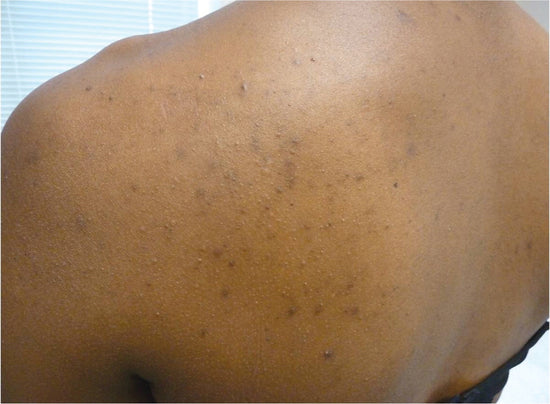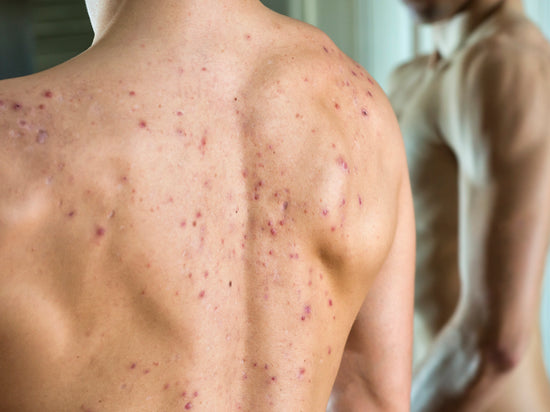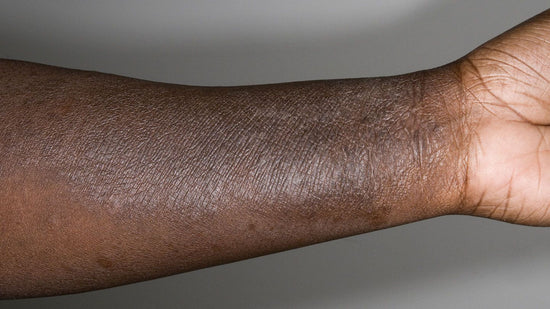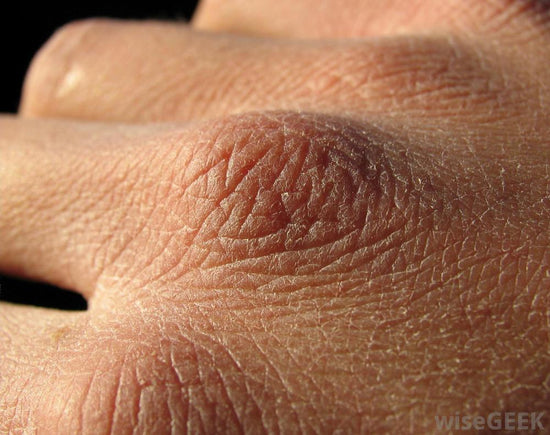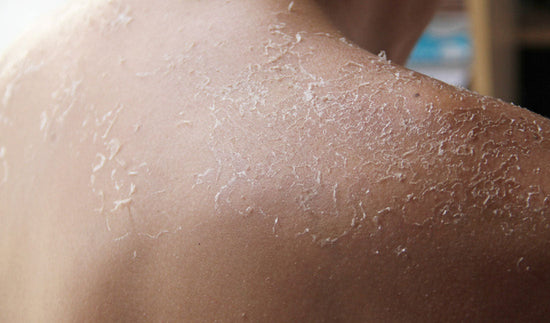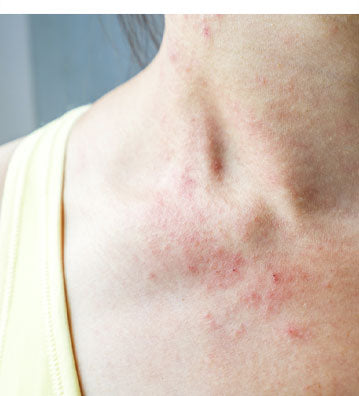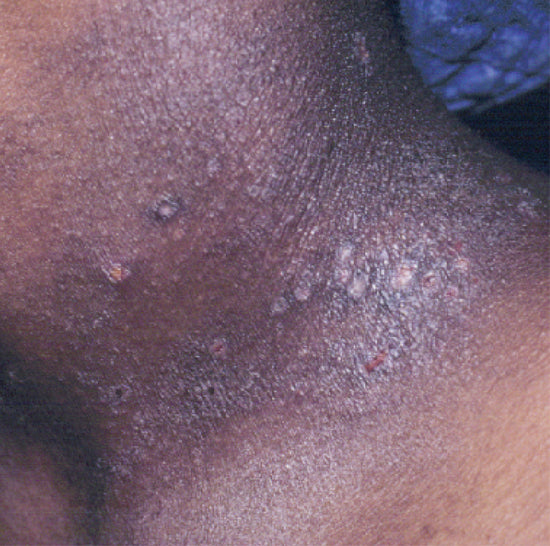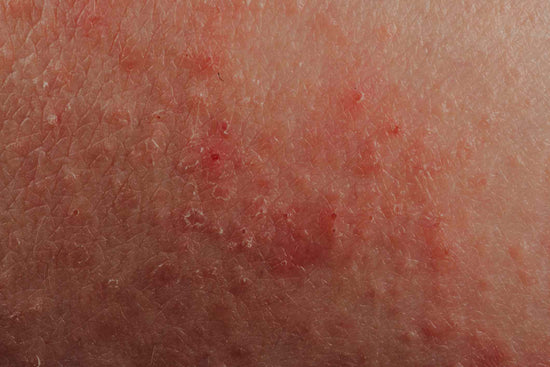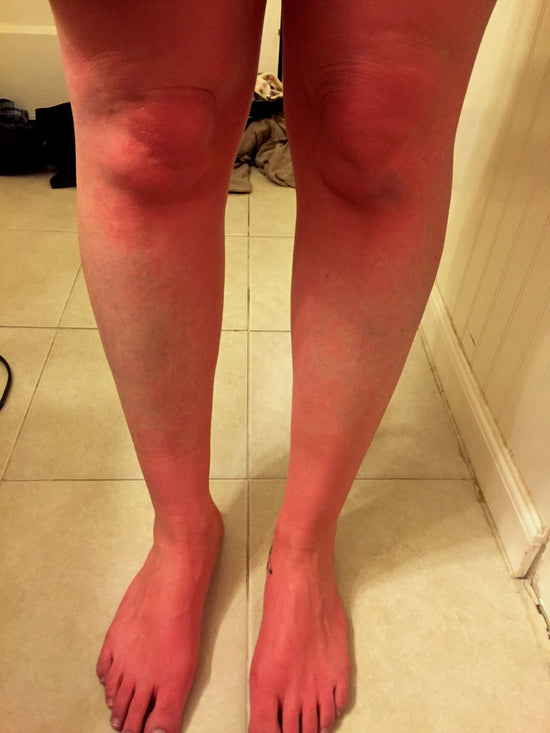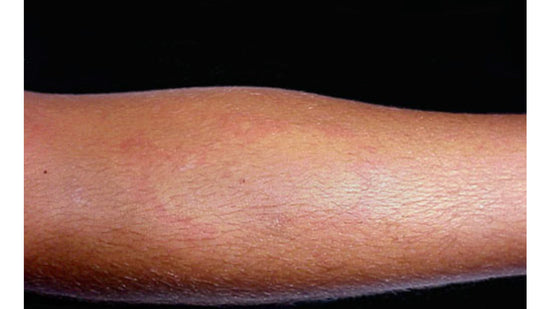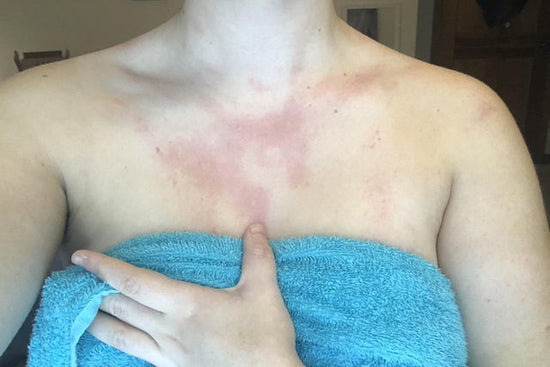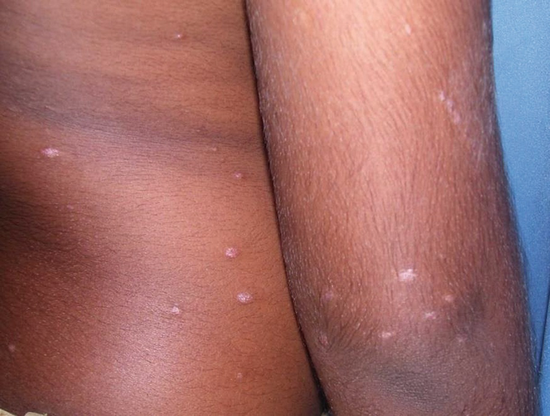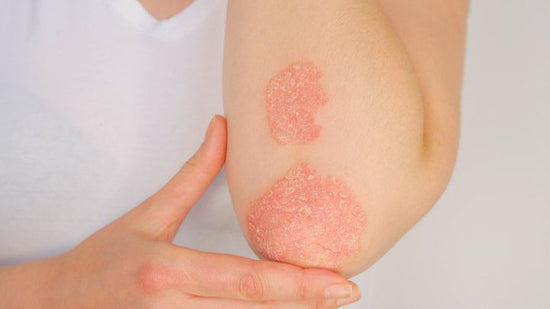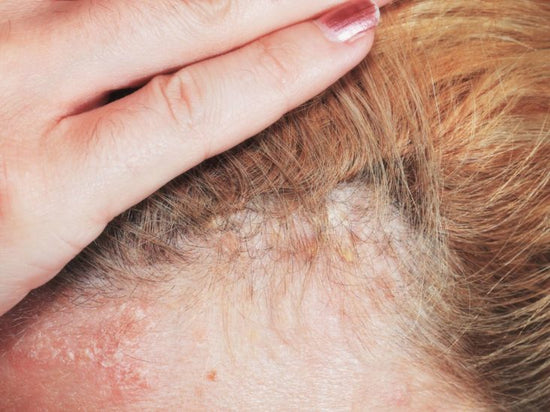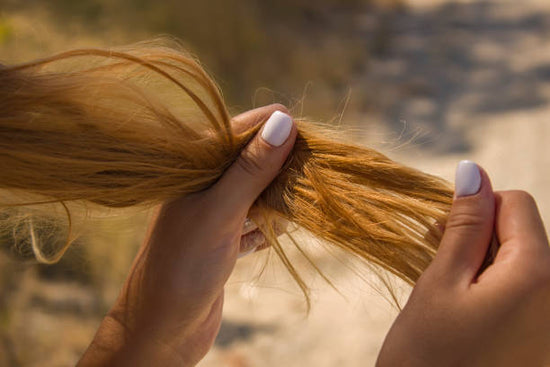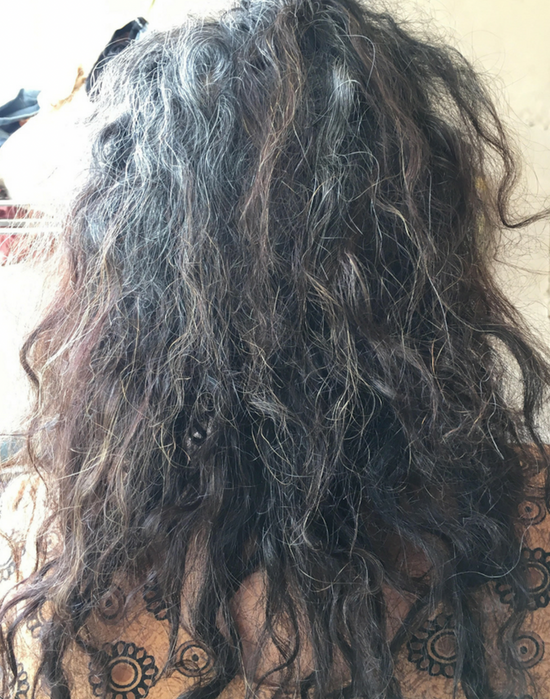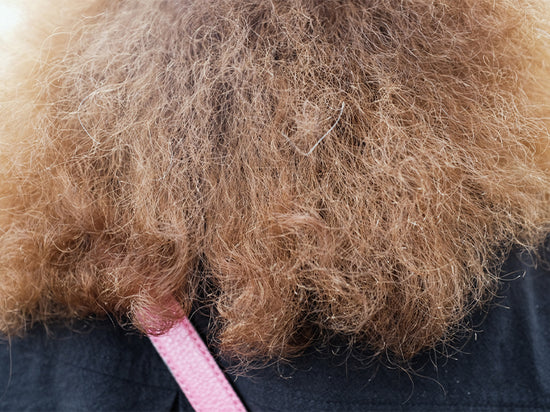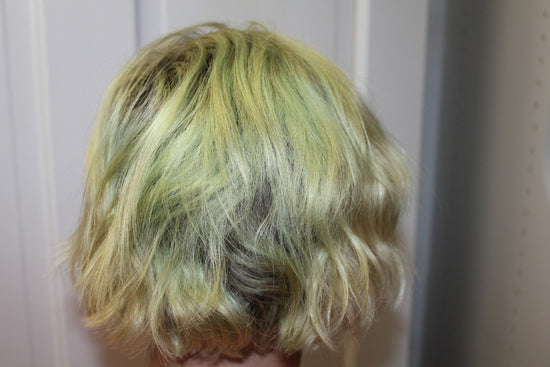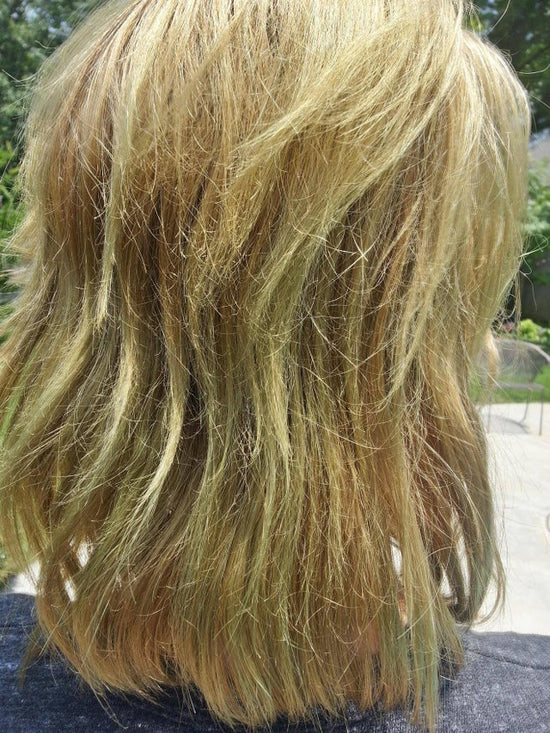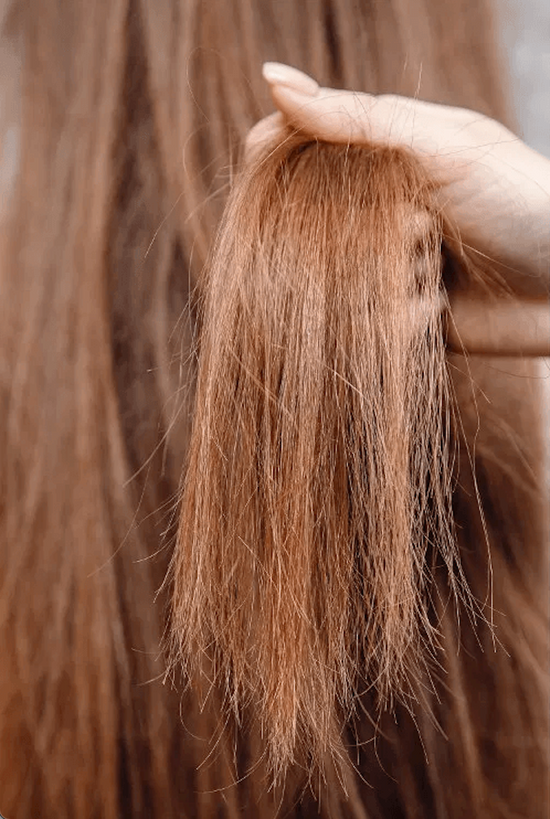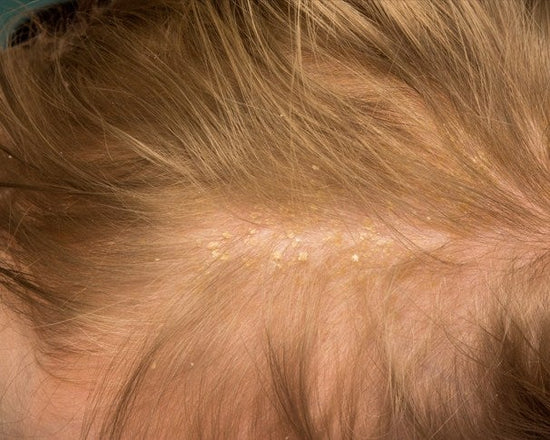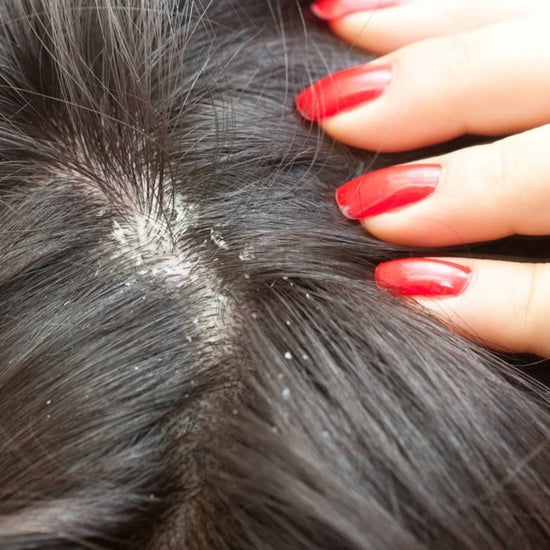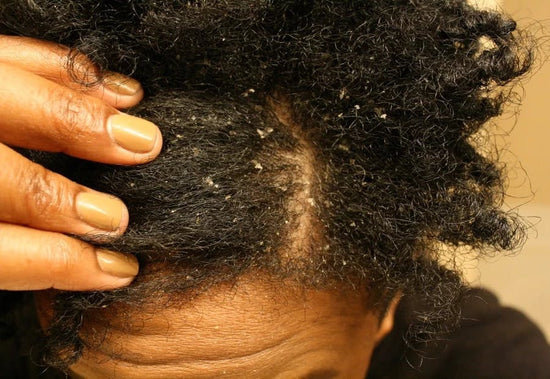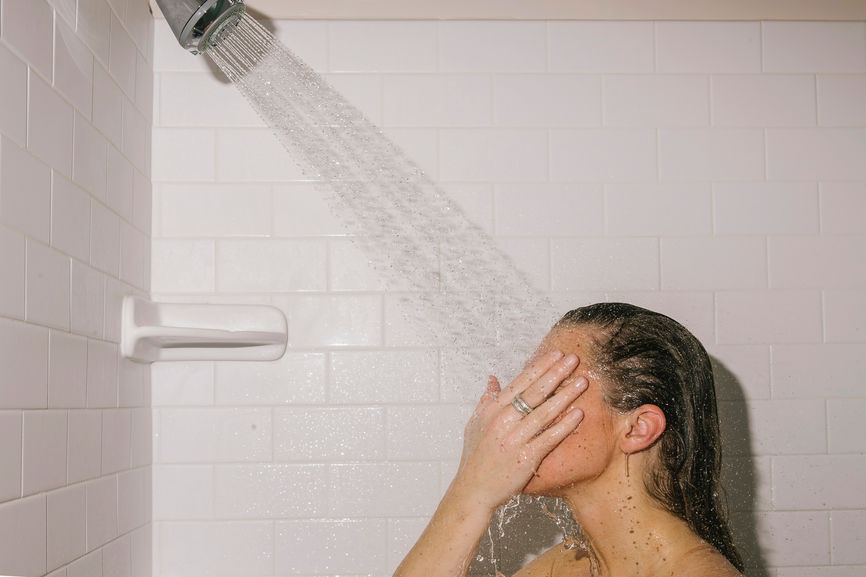
What's in your water?
Hard water is rich in minerals. In some cases, it can contain heavy metals and chlorine.
What are the signs? Soap not lathering sufficiently, clothes feeling rough to the touch, buildup of limescale, hair and skin issues.
Here's a list of common skin & hair issues aggravated by hard water and how to care.
Body Concerns
Body Acne: breakouts on your back, chest, and butt.
Collapsible content
What is body acne?
Body acne is breakouts, which show up on the back, chest, butt, and arms.
There are six different types of breakouts types with body acne: Blackheads (tiny black dots), whiteheads (tiny white dots), papules (small red spots), pustules (red bumps with pus), nodules (a larger version of a pimple), and cysts (softer boils tender to touch).
What's the cause?
The main contributing factors to acne are clogged pores, increased sebum production, inflammation, and bacteria. Sweat, dirt, oil, and friction can contribute to body acne too.
Not washing after a workout can manifest bacteria, leading to inflamed pores. Residue in shampoo and conditioner can clog pores and cause back acne. Tanning products can dry out the skin, leading to the sebaceous glands overproducing oil, causing chest breakouts.
Additionally, studies have found that high glycemic foods, such as processed snacks and sugar, can exacerbate acne.
What's the link with hard water?
Hard water can alter our skin's oil from a liquid to a wax-like texture. Causing clogged pores and issues ranging from blackheads and larger pimples to rosacea.
Also, calcium in hard water may irritate your skin, causing dry, scaly, pinkish patches. If you find your soap products don't thoroughly lather and leave a filmy residue after rinse off, you are most likely bathing with hard water.
How to treat?
Mild-to-moderate body acne might only need a few over-the-counter treatments and some lifestyle swaps, while severe cases may require a dermatologist appointment.
Shower immediately after a workout to avoid bacteria buildup in pores. Use a shower filter or water softener to reduce minerals, and also look for body cleansers containing chelating ingredients that prevent calcium and magnesium from clogging your pores. Chelating ingredients include Disodium EDTA, Tetrasodium EDTA, Trisodium Ethylenediamine Disuccinate, Pentasoidum Pentetate, Sodium Gluconate, Sodium Phytate and Phytic Acid. Rinse off any soap products thoroughly in the shower to prevent congestion.
If you can't shower straight after a gym session, change out of sweaty clothes as soon as possible as they can trap bacteria in the pores.
To fight existing acne, look for ingredients like Benzoyl Peroxide, an antimicrobial ingredient that kills bacteria and helps clear out clogged pores. Additionally, Salicylic Acid can unclog pores and help dry out pimples.
Dry skin: skin that's dehydrated and scales, itches, and cracks.
Collapsible content
What is dry skin?
Dry skin happens when your skin barrier loses water and oil. Symptoms can include scaling, flaking, peeling skin, skin that feels rough, tight-feeling skin after showers, itchiness, and cracks.
You can get dry skin anywhere on your body. But it commonly shows up on the hands, feet, arms, and lower legs.
People with lighter tones might have dry skin that’s red or pink. Darker tones may be hyper-pigmented, showing different patches of deeper colour.
What's the cause?
Dry skin is caused by a damaged skin barrier and a lack of healthy fats/oils in the top layer of the skin.
Exposure to dry weather conditions, hot water, and certain chemicals can dry out the skin.
Dry skin could also be caused by dermatitis, a medical condition where the skin is inflamed such as contact dermatitis, seborrheic dermatitis, and atopic dermatitis.
What's the link to hard water?
When water contains high amounts of calcium, it doesn't fully dissolve soap, meaning some residue is left behind. This can contribute to sensitive, irritable, and blemish-prone skin.
Many local cities add chlorine to tap water during the processing stage to kill microbes. This research suggests that exposure to chlorinated water causes dryness and increase sensitivity.
People with dermatitis-type conditions may suffer more if they live in an area with either chlorinated or hard water as the minerals and chemicals can act as an irritant for some, leading to potential flareups.
How to treat?
Keep shower time short (5-10 minutes max), use warm but not hot water, and limit baths, especially when the skin shows signs of dryness. Try to reduce exposure to chlorinated water when possible.
Use a gentle body cleanser that is hydrating and pH balanced, and apply moisturiser while your skin is still damp. To restore hydration, you may need to apply cream or lotion more than once a day.
Eczema: an inflammatory skin condition that causes dry, itchy skin and red, scaly patches.
Collapsible content
What is eczema?
Eczema is an inflammatory skin condition that causes dry skin, itchy skin, rashes, scaly patches, blisters, and infections. Itchy skin is the most common symptom of eczema.
There are seven different types of eczema: atopic dermatitis, contact dermatitis, dyshidrotic eczema, nummular eczema, seborrheic dermatitis, and stasis dermatitis.
What's the cause?
Many factors can contribute to eczema. When an internal or external irritant or an allergen "switches on" the immune system, it produces a flare-up on the skin's surface.
There is also a potential genetic component to eczema that includes a protein called "filaggrin" that helps maintain moisture in your skin; a filaggrin deficiency can lead to drier, itchier skin.
Additional common triggers of eczema: dry air, extreme heat, or cold. Some types of soap, shampoo, bubble bath, body wash, facial cleansers, hard water, certain fabrics like wool or polyester in clothing and sheets, heavy metals and stress.
What's the link with hard water?
Bathing in hard water raises the pH of the skin, which can affect the skin barrier's repairing abilities. In hard water, calcium and magnesium ions bind to surfactants (foaming agents) in soap, making it harder to rinse off completely. This leaves residue or "soap scum" on the skin, damaging the skin barrier, and irritating the skin, triggering eczema flareups.
Studies suggest that hard water reduces skin hydration, increases skin redness, increases the level of cytokines, which are proteins that drive inflammation.
The lead author of the study, Dr. Simon Danby from the University of Sheffield's Department of Infection, Immunity and Cardiovascular Disease, said: "Patients with eczema are much more sensitive to the effects of hard water than people with healthy skin. This increase in sensitivity is associated with a genetic predisposition to a skin barrier defect brought about by mutations in the gene encoding filaggrin. Filaggrin is a structural protein important for forming our skin's barrier to the outside environment. Up to half of all people with eczema carry a filaggrin gene."
How to treat?
There is no cure for eczema, but there are treatments such as medical-grade moisturising creams, prescription topical medications, over-the-counter (OTC) remedies, phototherapy (also known as light therapy), and immunosuppressants.
For most types of eczema, managing flareups comes down to knowing your triggers, implementing a daily bathing and moisturising routine, and using OTC creams and prescription medication consistently.
Topical creams and body moisturisers help relieve the dryness associated with eczema. In itchy situations, a topical steroid cream can help offer temporary relief. However, your doctor might prescribe an antibiotic cream when an OTC option isn't strong enough.
What about my shower routine?
The first step is to avoid long, hot showers. Although not a treatment, filtering your shower water helps reduce unwanted minerals and chlorine that can dry out your skin.
Avoid cleansers with harsh soaps as they can dry out your skin and trigger a flare-up. Look for dermatologist-tested products suitable for sensitive skin and avoid harsh physical scrubs.
Afterwards, pat dry and follow with a moisturiser. As skin with eczema cannot retain water very well, opt for a thicker oil-based cream compared to a thinner water-based lotion.
Shower rashes: skin that looks red and blotchy after a shower.
Collapsible content
What is a shower rash?
A shower rash can look like splotchy, red, irritated patches of skin that crop up on various parts of the body and may feel sensitive to the touch.
What causes a shower rash?
Causes of a shower rash can range from dry skin, dull razor blades, allergic reactions to contact dermatitis.
Rashes that develop in the shower can signify dehydrated skin. Xerosis cutis, also known as dry skin, is one of the most prominent causes of a rash after a shower. High-water temperatures can strip the skin of natural oils.
High-temperature showers can cause a skin rash exhibiting redness, swelling, itching, flaking, and even peeling.
Using old razor blades and shaving can cause folliculitis and inflame hair follicles. If the blade is dull, it may irritate the skin and cause redness.
Preexisting skin conditions can play a role in shower rashes too. Contact dermatitis can be aggravated after a hot shower, as the combination of hot water, stripping soaps, hard water, and chlorine can make the skin appear red, dry, and sensitive.
Hot showers can trigger, nerve fibres in the sweat glands that cause cholinergic urticaria. During a hot shower, your body temperature goes up, which may cause hives.
The products you use and temperature can also trigger rashes for those who have eczema, leading to flareups.
What's the link between hard water and a shower rash?
Hard water may contribute to skin dryness and aggravate existing conditions. If the skin barrier is compromised, mineral deposits in hard water can make it more prone to reactions and irritation.
Chlorine is an element that some cities use to disinfect tap water. For some, the chemical can even cause a 'chlorine rash' after a hot shower.
How to treat?
You can usually treat a chlorine rash with over-the-counter (OTC) products, including corticosteroid creams, such as hydrocortisone. Additionally, consider installing a shower filter to reduce chlorine and unwanted minerals in your water.
Stick to gentle body cleansers that are non-stripping and low in fragrance. Then apply a soothing body lotion to the skin twice a day to keep skin well moisturised and prevent irritation.
Skip body products that contain high concentration acids, retinol, or retinoids. These ingredients are designed to increase the rate of skin cell turnover and can be a cause of dry skin.
Should a rash develop after shaving in the shower, it could be time for a new razor. Instead of rubbing your skin with a towel to dry after showering, gently pat the skin to reduce irritation.
Psoriasis: autoimmune disease where skin cells build up and create rough, scaly patches.
Collapsible content
What is psoriasis?
Psoriasis is a chronic autoimmune skin disease with raised, inflamed patches of skin that appear red on light skin and brown or purple on dark skin, and feel sore to the touch.
The lower back, knees, elbows, and legs are commonly affected areas. However, flareups can also affect the feet, palms, scalp, and face as well.
What's the cause?
Doctors have narrowed down two key factors that cause psoriasis: genetics and the immune system.
For the average human body, skin cells grow deep in the skin's layers and rise to the surface, eventually flaking off.
With psoriasis, the skin cells on the body build up more rapidly, meaning that the skin cells have no time to fall off on their own and leading to a thick, scaly-looking layer of skin cells that can become infected.
With psoriasis, one size doesn't fit all. Symptoms differ from person to person, and the severity can vary.
What's the link with hard water?
While there is no evidence that hard water causes psoriasis, the minerals in hard water have a drying effect on the skin and can worsen psoriasis and other issues.
How to treat?
Like eczema, psoriasis has no cure; it will always exist in the body. However, certain treatments can reduce inflammation, slow the overgrowth of skin cells, and remove plaque are all effective ways to make psoriasis more manageable.
Topical steroid creams are applied directly to the skin to reduce redness, itchiness, and inflammation. As topical steroids, including corticosteroids and retinoids, come with different strengths, they are best bought after consulting with a doctor.
Other topical solutions may be gentle soaps that won't irritate the skin. Vitamin D3 and A can also be applied as anti-inflammatories on the skin. Or anthralin, a medicated cream that slows the body's production of skin cells in that area.
Scalp psoriasis is different from dandruff (caused by a fungus). It usually appears around the hairline and neck as a raised patch of rough skin.
Look for ingredients such as Salicylic Acid that helps soften plaques and scales, coal tar which slows skin cell growth and reduces scaling, and Apple Cider Vinegar which may help soothe itches.
Light therapy is becoming a popular treatment for severe psoriasis. The production of Vitamin D is protective in the skin, and anti-inflammatory properties can slow the growth of skin cells and reduce psoriasis lesions.
What about my shower routine?
Long, hot showers and baths can dry your skin, which can trigger flareups. Although not a treatment, filtering your shower water helps reduce unwanted minerals and chlorine that can dry out the skin.
Reduce the amount of bath or showers to once a day, and limit it to under 10 minutes. Opt for warm water instead of hot and use a gentle, moisture-rich body cleanser made for sensitive skin; steer away from loofahs, which can irritate your skin.
Gently dry your skin by blotting with a towel, leave a bit of water on your skin so that it feels damp. Then follow with a fragrance-free moisturiser to all of your skin within five minutes of taking a shower or bath.
Hair & Scalp Concerns
Dry hair: hair that lacks moisture and oil to maintain its normal sheen.
Collapsible content
What is dry hair?
Dry hair develops when your hair doesn't get or retain enough moisture. This reduces shine and can make it look frizzy and dull. Sheen and lustre are two vital signs of healthy hair. When your hair is dry, the outer layer breaks down, causing it to appear dull and unhealthy.
There's a difference between dry hair and damaged hair. To find out, pluck one strand of wet hair from your head and gently pull the hair at either end. If the hair strand stretches by about one-third before returning to its original length, your hair is healthy. If your strand doesn't stretch or only stretches a small amount and breaks, that means your hair is damaged and lacks protein. Should your hair stretch but not return, it is likely to be dry rather than damaged.
What's the cause of dry hair?
The outer layer of hair can become damaged from external aggressors like weather, over-styling, hard water, shower habits, and overall health conditions. These factors can cause the cuticle to lift, allowing moisture to escape, and leaving hair looking and feeling rough.
During the summer months, heat and UV levels from the sun pull the moisture out of your hair and break down the hair's pigment necessary to filter the light radiation. If you're a frequent swimmer or if your tap water is chlorinated, the harsh drying effects of chlorine and salty seawater can leave your hair feeling dry too.
Dyeing, bleaching and chemically styling are processes that can weaken and break the pigment of your hair and swell your cuticles, leading to a dry and damaged look and feel. Also, excessive heat styling may cause your hair to lose moisture over time.
Dryness and different hair types
Hair types play a big part when it comes to dryness.
Here's the basic rundown of the categories: type 1(straight hair), type 2(wavy hair), type 3(curly hair), type 4 hair(coily hair). Each category also has three a, b, and c subcategories (ex: 3a, 3b, 3c, or 4a, 4b, 4c) that break down each hair type even further.
Type 1: Straight hair can range from thin and silky to thick and poofy. There's one commonality: shine. The oils from the roots can easily slip and slide down the hair, keeping it moisturised.
Type 2: Wavy hair tends to have definitive bends from roots to tips. Type 2 waves can range from beachy waves to undefined curves and bumps and can be more prone to frizz.
Type 3: Curly hair spirals around like a spring, versus waves in a flat S-shape. Curly hair is more prone to dryness and breakage than straight and waves.
Type 4: Coily hair can have a mix of textures that range from a tightly coiled, spring-like pattern (S-shape) to a zigzag pattern that doesn't curl around itself (Z-shape). Type 4 hair is the most fragile, dry, and damage-prone of all hair types.
Curly and coily hair types are most prone to dryness, especially at the ends, because of the natural bends in their structure. The Z structure makes it harder for the natural oils to coat strands from root to ends.
What's the link with hard water?
Hard water can coat your hair with a film of mineral buildup. This leaves your hair feeling filmy, straw-like, and weighs down curls, causing them to look 'limp.' Hard water erodes the hair's elasticity as it lifts the cuticle, leading to easier accumulation of buildup.
How to treat dry hair?
Lower the temperature of styling tools. Depending on your hair type, find the lowest temperature that will let you style without incurring heavy damage.
Hair is more fragile when it's wet and more prone to breakage. Apply conditioner first when brushing your hair in the shower to reduce breakage.
If you live in a hard water area, look for products that use Apple Cider Vinegar as its hero ingredient, which helps combat dryness and dullness caused by minerals in your water. ACV is filled with natural acids that help to dissolve hard water and product buildup while also soothing irritated, itchy scalps. It gently clarifies, making it perfect for curly and frizzy hair.
Look for clarifying, chelating, or demineralising ingredients like EDTA or Phytic Acid to help remove mineral and chlorine buildup, along with acidic products that help balance the scalp pH.
Installing a shower filter will reduce unwanted minerals and chlorine that touch your hair.
A deep treatment mask will replenish hair strength of nutrients and moisture. Additionally, leave-in treatments work hard to protect your hair from external pollutants and the protective coating that the treatment will leave in your hair.
Discoloured hair: brassy, orange, yellow and green hues in your strands.
Collapsible content
What is discoloured hair?
Going from dark to blonde involves applying a mixture of ammonia and peroxide (bleach) to the hair. This process dilutes the darker pigment in the hair.
However, you may notice a colour transition as time passes. Your hair may start to appear slightly orange or brassy.
Bleached hair doesn't fade back to your natural hair colour. However, it can become darker or duller over time if the toner washes out, leading to yellow pigments becoming visible again. Bleach also makes hair more porous, meaning it absorbs minerals in water and products that cause discolouration and brassiness.
All permanent hair dye will eventually start to fade and change shade over time for dyed hair. The colour you choose will also influence how long your hair will stay vibrant.
What causes discoloured hair?
Hair dye contains three pigment colours: blue, red, and yellow. The blue molecules tend to fade away faster, which leaves red and yellow, which makes orange.
Hair discolouration can be affected by the colour's chemistry, hard water, chlorine, and overall hair health and dyeing history.
In hard water, chlorine and copper can bond together to form a film that sticks to the proteins in each strand of hair, causing hair to turn green. Additionally, copper can be found on some pipes as well.
Iron and manganese content in hard water are oxidisers that cause lighter hair to look orange and create a coppery red hue for darker hair
How to treat?
Try washing your hair every other day or even every three days and opt for products that are sulphate-free and non-stripping.
Before going into the pool or ocean, soak hair with clean tap water, so it can't absorb chlorinated and saltwater. Rinse after your swim before your hair dries.
Investing in a shower filter that reduces chlorine, copper, and iron is a great way to prevent tap water from dulling out your hair colour.
On sunny days, wear a hat, as the UV not only fades colour but exposes the remaining natural pigments, which are usually the brassy and unwanted tones.
Excessive heat from styling can destroy the molecules in hair colour. Opt for tools that only reach a safe temperature for colour-treated hair and follow with nourishing treatments a minimum once a week
Itchy scalp: frequent scratching, discomfort and flakes.
Collapsible content
What is an itchy scalp?
An itchy scalp feels tingly and sensitive. Symptoms may include bald patches, dry flakes, irritated skin, redness, scales, dry patches, swelling, and sores.
What's the cause?
The most common cause of an itchy scalp is seborrheic dermatitis, most commonly known as dandruff, which often occurs in sebaceous or oil-secreting glands that become inflamed.
While it's difficult to pin down the exact cause of dandruff, some potential causes may include yeast overgrowth, seasonal changes, hormonal fluctuations, or stress.
Scalp itchiness may simply result from sensitivity, which can be aggravated with product buildup and hard water. In some cases, an itchy scalp can also indicate an underlying medical condition such as diabetes, shingles, allergic reactions, contact dermatitis, head lice, psoriasis, and scarring alopecia.
What's the link to hard water?
The hair's porosity creates a physical barrier for your scalp, which can trap calcium and magnesium deposits from hard water.
Hard water can upset the oil balance on your scalp. For fine, straight hair prone to grease, hard water can dry the scalp where it becomes dehydrated and oily, as sebaceous glands tend to produce more oil to make up for the 'lack of it.' If your scalp is on the dry side, hard water can dehydrate it further and cause flakes.
Hard water reduces lather and leaves behind a white substance called soap scum, which is insoluble in water, making shampoo harder to rinse off. In turn, this leaves behind buildup on your scalp, which can block follicles and affect the hair's integrity. A study found that hard water areas increase surfactant deposits, and this residue increased transepidermal water loss and increased irritation for patients with Atopic Dermatitis conditions.
Additionally, alkalinity in hard water (pH7.5+) can disrupt the scalp's naturally acidic pH, making it prone to irritation.
How to treat a flakey, itchy scalp?
Treatment for your itchy scalp depends on the root of the issue. For dandruff, some medications include antifungal creams, salicylic acid, apple cider vinegar, coal tar, pyrithione zinc, topical steroids. In contrast, head lice require medical treatments, such as washing the hair with a pediculicide.
Always patch test new shampoos, scalp cleansers, and other topical products, as they may cause an allergic reaction that can lead to sensitivity.
Reduce itching by regularly clarifying the scalp from hard water, pollution, and product buildup. Wash your hair in warm water to avoid irritating and drying out the scalp. Although not a cure, a shower filter reduces unwanted minerals and chlorine, which can be drying for the scalp.

